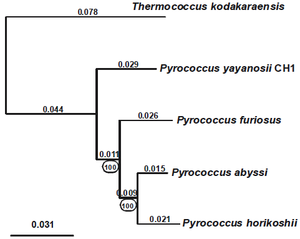Pyrococcus yayanosii
A Microbial Biorealm page on the genus Pyrococcus yayanosii
Classification
Higher order taxa
Domain (Archaea); Phylum (Euryarchaeota); Class (Thermococci); Order (Thermococcales); Family (Thermococcaceae); Genus (Pyrococcus)
Species
NCBI: Taxonomy[2] Pyrococcus yayanosii CH1
Description and significance
P. yayanosii CH1 was found in March of 2007, in a hydrothermal vent field "Ashadze" 4.1 kilometers underwater. It is the first obligate piezophilic (barophilic) hyperthermophilic archaeon to be isolated and observed. CH1 was discovered in black smoker samples that were:
- Anaerobically (all steps)
- stored in a sterile sampling box filled with deionized (sterile) fresh water
- crushed in an anaerobic chamber on board
- distributed into syringes holding artificial seawater
- reduced with Na2S
- pressurized at 40MPa
- held at 4°C before analysis
In the lab, sub-samples were:
- enriched in modified MJYP medium
- adjusted to pH 7
- supplemented with
- 20mM NaNO3
- 5mM FeSO4
- 1mg/L rezasurin for monitoring anaerobiosis
- incubated in a custom high-pressure and high-temperature system
- pressurized to in-situ 42MPa
- heated to 85°C, 95°C, or 105°C
After incubating for 2 days, dilution-to-extinction of a culture at 95°C yielded an isolate of CH1.[3]
Genome structure
The complete genome sequence of P. yayanosii CH1 was reported in June of 2011 as containing 1,716,818 base pairs, 1952 genes (1902 for proteins and 50 for RNA) and a guanine-cytosine content of 51.6%.[4,5] This is a higher G+C content than found in other Pyrococcus species, as is the ratio of the amino acids alanine and arginine. Higher G+C content results in higher melting points, and thus may correlate with CH1's high temperature tolerance. Higher ratios of amino acids that are lower in molecular weight and higher in polarity, such as alanine and arginine, are thought to be related to piezophilicity. 16S rRNA gene sequence comparison showed a 99.4% similarity to Pyrococcus furiosus.
Genome summary
- Pathways: 92
- Enzymatic Reactions: 582
- Transport Reactions: 45
- Polypeptides: 1865
- Protein Complexes: 9
- Enzymes: 471
- Transporters: 89
- Compounds: 537
- Transcription Units: 1105
- tRNAs: 46
Cell and colony structure
CH1 is an irregular, gram negative coccoid cell 0.6-1.4 micrometers in diameter with high motility. Motility derives from monotrichous flagella. Colony structure has yet to be described.
Metabolism
P. yayanosii CH1 is described as chemoorganotrophic, growing via anaerobic fermentation of substrates. CH1 grows well on complex proteinaceous carbon sources (e.g. peptone, casein, tryptone, yeast or beef extract) with growth stimulated by primarily sulfur, but also cystin and to a lesser extent thiosulfate – all of which lead to hydrogen sulfide production. Sulfate, nitrate, and thiosulfate, however, are not used as electron acceptors. It can also grow on sucrose, starch, chitin, pyruvate, acetate, and glycerol substrates, without the electron acceptors. CH1 shows weak growth on glucose and no growth on maltose, casamino acids, or tryptophan substrates. Under optimal growth conditions, the generation time was observed to be ~50 minutes.
Ecology
CH1 is both an obligate anaerobe and obligate piezophile. It grows at temperatures between 80-108°C (176-226°F), with 98°C (208°F) being ideal. Growth is at pressures between 20-120 megapascals (197-1184 atmospheres), with 52 MPa (513 atm) being ideal. It prefers neutral to slightly basic pH (6-9.5 with a preferred 7.5-8) and saline concentrations of 2.5-5.5% (3.5% NaCl preferred).
Pathology
CH1 is not known to be pathogenic to humans or other species.
References
[1] Zeng, X., J. L. Birrien, Y. Fouquet, G. Cherkashov, M. Jebbar, J. Quérellou, P. Oger, M. A. Cambon-Bonavita, X. Xiao, and D. Prieur (2009) Pyrococcus CH1, an obligate piezophilic hyperthermophile: extending the upper pressure-temperature limits for life, ISME J. 3: 7, 873-876; doi: 10.1038/ismej.2009.21
[2] <http://www.ncbi.nlm.nih.gov/Taxonomy/Browser/wwwtax.cgi?id=529709>
[3] Birrien, J. L., X. Zeng, M. Jebbar, M. A. Cambon-Bonavita, J. Quérellou, P. Oger, N. Bienvenu, X. Xiao, and D. Prieur (2011) Pyrococcus yayanosii sp. nov., an obligate piezophilic hyperthermophilic archaeon isolated from a deep-sea hydrothermal vent, Int J Syst Evol Microbiol 61: 12, 2827-2831; doi: 10.1099/ijs.0.024653-0
[4] Jun, X., L. Lupeng, X. Minjuan, P. Oger, W. Fengping, M. Jebbar, and X. Xiang (2011) Complete genome sequence of the obligate piezophilic hyperthermophilic archaeon Pyrococcus yayanosii CH1, J Bacteriol 193: 16, 4297-4298; doi: 10.1128/JB.05345-11
[5] <http://www.metacyc.org/organism-summary?object=PYAY529709>
[6] <http://www.p2cs.org/page.php?base=PyryaDB&PHPSESSID=02f7745e5e47fe34df364a1812335fd1>
Edited by Candice Blodgett, student of Dr. Lisa R. Moore, University of Southern Maine, Department of Biological Sciences, http://www.usm.maine.edu/bio



